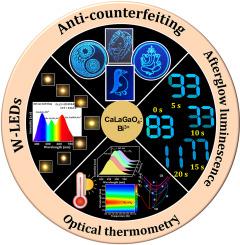具有持久余辉的宽带蓝色发光CaLaGaO4:Bi3+荧光粉,适用于高cri w- led和先进的防伪应用
IF 5.6
2区 材料科学
Q1 MATERIALS SCIENCE, CERAMICS
引用次数: 0
摘要
采用溶液燃烧技术合成了一系列未掺杂和(0-9 mol %) Bi3+掺杂的CaLaGaO4荧光粉,显示出余辉发光。紫外可见吸收光谱表明,合成的荧光粉具有直接带隙,未掺杂样品的带隙为5.168 eV,掺杂5 mol % Bi3+的样品的带隙为3.874 eV。在361 nm激发下,室温下在370 ~ 600 nm范围内检测到以448 nm为中心的宽发射带,这归因于Bi3+离子的3P1→1so0电子跃迁。在CaLaGaO4基体中加入5 mol %的Bi3+离子,可获得以448 nm为中心的强蓝色发光,半峰宽(FWHM)为90 nm,色纯度高达87.6%,420 K时的热稳定性为86.0%,活化能(Ea)为0.30 eV。在5 mol % Bi3+掺杂水平下,观察到最佳的余辉强度和衰减寿命。此外,CaLaGaO4:5Bi3+荧光粉在水中浸泡15天后保持了93.10%的原始发光,在85%的相对湿度下浸泡15天后保持了92.82%的原始发光。利用这种独特的CaLaGaO4:5Bi3+荧光粉,在365 nm芯片的激发下,成功制备了高性能的白光发光二极管(w-LED)器件。由此产生的磷转换w-LED显示出令人印象深刻的显色指数(Ra)为94.0和令人愉快的相关色温(CCT)为5426 K,表明照明应用的强大前景。此外,它作为安全油墨的功能表明它适合加密和防伪(AC)技术。该研究强调了其在先进光学标签系统、时间门控显示技术和光数据存储方面的潜力。发光快速响应(QR)码的成功创建和解码,以及它的时间分辨衰减行为,增强了CaLaGaO4:5Bi3+荧光粉在交流和安全应用中的能力。总的来说,这项工作为开发下一代宽带蓝色发光荧光粉提供了重要的见解,这些荧光粉专为高cri w- led和数据安全技术量身定制。本文章由计算机程序翻译,如有差异,请以英文原文为准。

Broadband blue-emitting CaLaGaO4:Bi3+ phosphors with persistent afterglow for High-CRI w-LEDs and advanced anti-counterfeiting applications
A series of un-doped and (0–9 mol %) Bi3+ doped CaLaGaO4 phosphors exhibiting afterglow luminescence were synthesized using the solution combustion technique. UV–Vis absorption spectra showed that the synthesized phosphors possess a direct bandgap, with values of the 5.168 eV for the undoped sample and 3.874 eV for the sample doped with 5 mol % Bi3+. Under excitation at 361 nm, a broad emission band centered at 448 nm was detected in the 370–600 nm range at room temperature, attributed to the 3P1→1S0 electronic transition of Bi3+ ions. Incorporating 5 mol % Bi3+ ions into the CaLaGaO4 matrix resulted in intense blue luminescence centered at 448 nm, with a full width at half maximum (FWHM) of 90 nm, high color purity of 87.6 %, excellent thermal stability of 86.0 % of the integrated emission at 420 K, and an activation energy (Ea) of 0.30 eV. The optimal afterglow intensity and decay lifetime were observed at the 5 mol % Bi3+ doping level. Furthermore, the CaLaGaO4:5Bi3+ phosphor retained 93.10 % of its original luminescence after 15 days of immersion in water and 92.82 % after 15 days in 85 % relative humidity. A high-performance white light emitting diode (w-LED) device was successfully fabricated by employing this unique CaLaGaO4:5Bi3+ phosphor, excited by a 365 nm chip. The resulting phosphor-converted w-LED demonstrated an impressive colour rendering index (Ra) of 94.0 and a pleasant correlated color temperature (CCT) of 5426 K, indicating strong promise for lighting applications. Additionally, its functionality as a security ink reveals its suitability for encryption and anti-counterfeiting (AC) technologies. The study underscores its potential in advanced optical tagging systems, time-gated display technologies, and optical data storage. The successful creation and decoding of a luminescent quick response (QR) code, along with its time-resolved decay behavior, reinforce the capability of CaLaGaO4:5Bi3+ phosphors in AC and security applications. Overall, this work provides important insights for the development of next-generation broadband blue-emitting phosphors tailored for high-CRI w-LEDs and data security technologies.
求助全文
通过发布文献求助,成功后即可免费获取论文全文。
去求助
来源期刊

Ceramics International
工程技术-材料科学:硅酸盐
CiteScore
9.40
自引率
15.40%
发文量
4558
审稿时长
25 days
期刊介绍:
Ceramics International covers the science of advanced ceramic materials. The journal encourages contributions that demonstrate how an understanding of the basic chemical and physical phenomena may direct materials design and stimulate ideas for new or improved processing techniques, in order to obtain materials with desired structural features and properties.
Ceramics International covers oxide and non-oxide ceramics, functional glasses, glass ceramics, amorphous inorganic non-metallic materials (and their combinations with metal and organic materials), in the form of particulates, dense or porous bodies, thin/thick films and laminated, graded and composite structures. Process related topics such as ceramic-ceramic joints or joining ceramics with dissimilar materials, as well as surface finishing and conditioning are also covered. Besides traditional processing techniques, manufacturing routes of interest include innovative procedures benefiting from externally applied stresses, electromagnetic fields and energetic beams, as well as top-down and self-assembly nanotechnology approaches. In addition, the journal welcomes submissions on bio-inspired and bio-enabled materials designs, experimentally validated multi scale modelling and simulation for materials design, and the use of the most advanced chemical and physical characterization techniques of structure, properties and behaviour.
Technologically relevant low-dimensional systems are a particular focus of Ceramics International. These include 0, 1 and 2-D nanomaterials (also covering CNTs, graphene and related materials, and diamond-like carbons), their nanocomposites, as well as nano-hybrids and hierarchical multifunctional nanostructures that might integrate molecular, biological and electronic components.
 求助内容:
求助内容: 应助结果提醒方式:
应助结果提醒方式:


